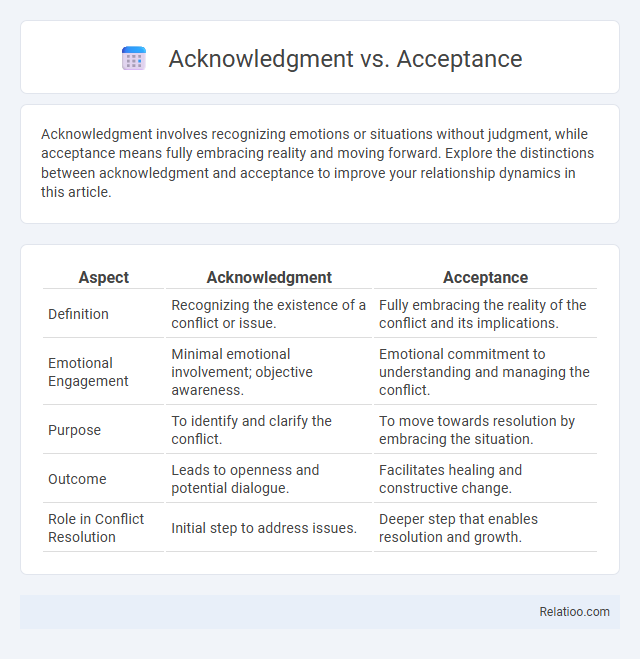Acknowledgment involves recognizing emotions or situations without judgment, while acceptance means fully embracing reality and moving forward. Explore the distinctions between acknowledgment and acceptance to improve your relationship dynamics in this article.
Table of Comparison
| Aspect | Acknowledgment | Acceptance |
|---|---|---|
| Definition | Recognizing the existence of a conflict or issue. | Fully embracing the reality of the conflict and its implications. |
| Emotional Engagement | Minimal emotional involvement; objective awareness. | Emotional commitment to understanding and managing the conflict. |
| Purpose | To identify and clarify the conflict. | To move towards resolution by embracing the situation. |
| Outcome | Leads to openness and potential dialogue. | Facilitates healing and constructive change. |
| Role in Conflict Resolution | Initial step to address issues. | Deeper step that enables resolution and growth. |
Understanding Acknowledgment and Acceptance
Understanding acknowledgment involves recognizing receipt or awareness of information without implying agreement or approval. Acceptance, however, denotes an explicit agreement or approval, often with legal or formal implications. Clear differentiation between acknowledgment and acceptance is crucial in contracts and communication to avoid misunderstandings and ensure mutual clarity.
Defining Acknowledgment: Meaning and Context
Acknowledgment refers to the act of recognizing or admitting the existence, truth, or validity of something, often serving as a formal statement that confirms receipt or awareness. In legal and business contexts, acknowledgment can signify confirming the terms of a document or agreement without implying consent or approval. Understanding your acknowledgment's meaning and context is essential to distinguish it from acceptance, which involves agreeing to the terms and conditions presented.
What Does Acceptance Really Entail?
Acceptance entails a deliberate and informed decision to embrace an offer or situation, creating a binding agreement between parties. Unlike acknowledgment, which merely confirms receipt or awareness without commitment, acceptance signifies consent and readiness to comply with terms. In legal and contractual contexts, acceptance transforms an offer into enforceable obligations, underscoring its critical role in agreement formation.
Key Differences Between Acknowledgment and Acceptance
Acknowledgment involves recognizing or confirming the receipt of information, while Acceptance signifies agreement or approval of terms or conditions. The key differences lie in their legal implications; acknowledgment does not imply consent or approval, whereas acceptance establishes a binding agreement or contract. Understanding these distinctions is crucial in contract law and communication to ensure clarity of intent between parties.
Psychological Impact of Acknowledging vs Accepting
Acknowledging emotions involves recognizing and validating feelings without necessarily changing one's relationship to them, which can reduce internal resistance and promote emotional clarity. Acceptance goes further by embracing emotions fully, allowing individuals to experience feelings without judgment, often leading to greater psychological resilience and reduced stress. The psychological impact of acknowledging is primarily relief through validation, whereas acceptance fosters long-term emotional balance and adaptive coping strategies.
When to Acknowledge and When to Accept
Acknowledgment involves recognizing receipt or awareness of information without implying agreement, typically used in professional or legal communication to confirm that a message or document has been received. Acceptance denotes formal consent or approval of terms, conditions, or offers, often leading to contractual obligations or commitments once conveyed. Understanding when to acknowledge versus when to accept is crucial: acknowledge to confirm receipt or awareness without obligation, accept to indicate agreement and initiate binding actions or responsibilities.
Practical Examples: Acknowledgment vs Acceptance
Acknowledgment confirms receipt or awareness of information, such as signing a delivery receipt, while acceptance signifies agreement or approval, like signing a contract to finalize a deal. You acknowledge when you confirm understanding of terms, but accept when you agree to be bound by them. Practical examples highlight how acknowledgment ensures communication, whereas acceptance creates legal obligations.
The Role of Acknowledgment in Conflict Resolution
Acknowledgment plays a crucial role in conflict resolution by validating the feelings and perspectives of all parties involved, which helps to build trust and open communication channels. Unlike acceptance, which implies agreement or approval, acknowledgment merely recognizes an issue or emotion without necessarily endorsing it. This recognition fosters empathy and de-escalates tension, serving as a foundational step toward achieving mutual understanding and resolution.
Acceptance and Emotional Growth
Acceptance involves embracing reality and your emotions without resistance, fostering emotional growth and resilience. Unlike mere acknowledgment, which is recognizing facts or feelings, acceptance requires a deeper internal shift that promotes healing and self-awareness. Your ability to practice acceptance can lead to greater mental well-being and improved emotional regulation.
Choosing Between Acknowledgment and Acceptance in Real Life
Choosing between acknowledgment and acceptance depends on your emotional response and the situation's context. Acknowledgment involves recognizing facts or feelings without necessarily agreeing or embracing them, while acceptance signifies a deeper level of agreement or embracing reality as it is. Understanding this distinction helps you navigate personal and professional experiences by managing expectations and fostering emotional resilience.

Infographic: Acknowledgment vs Acceptance
 relatioo.com
relatioo.com